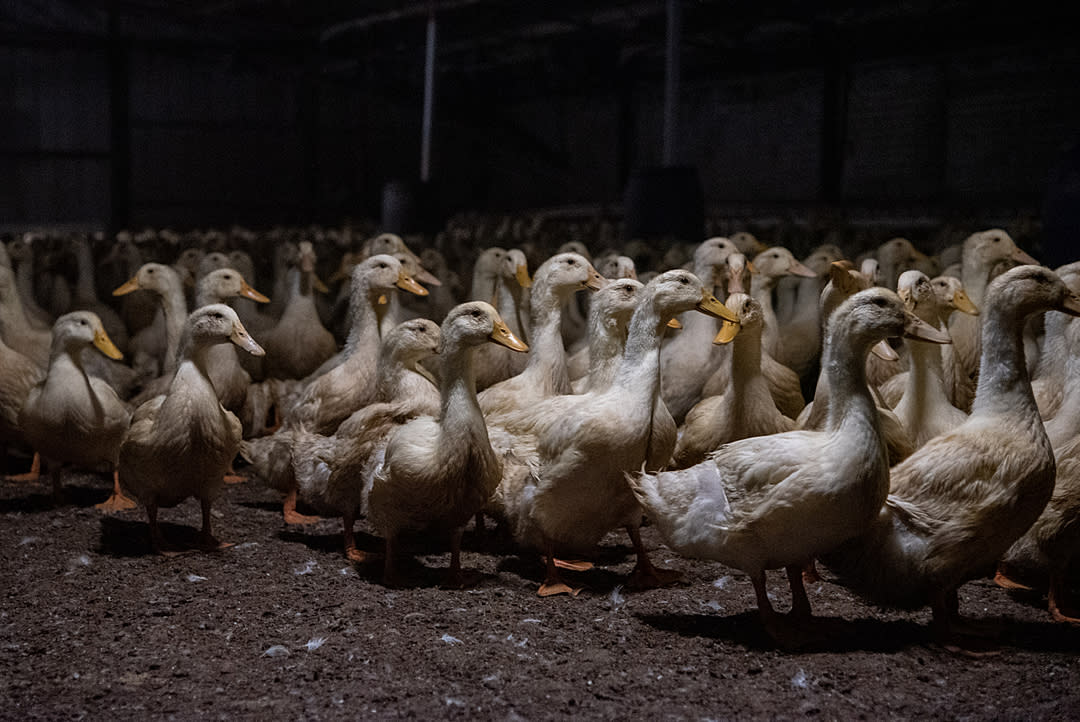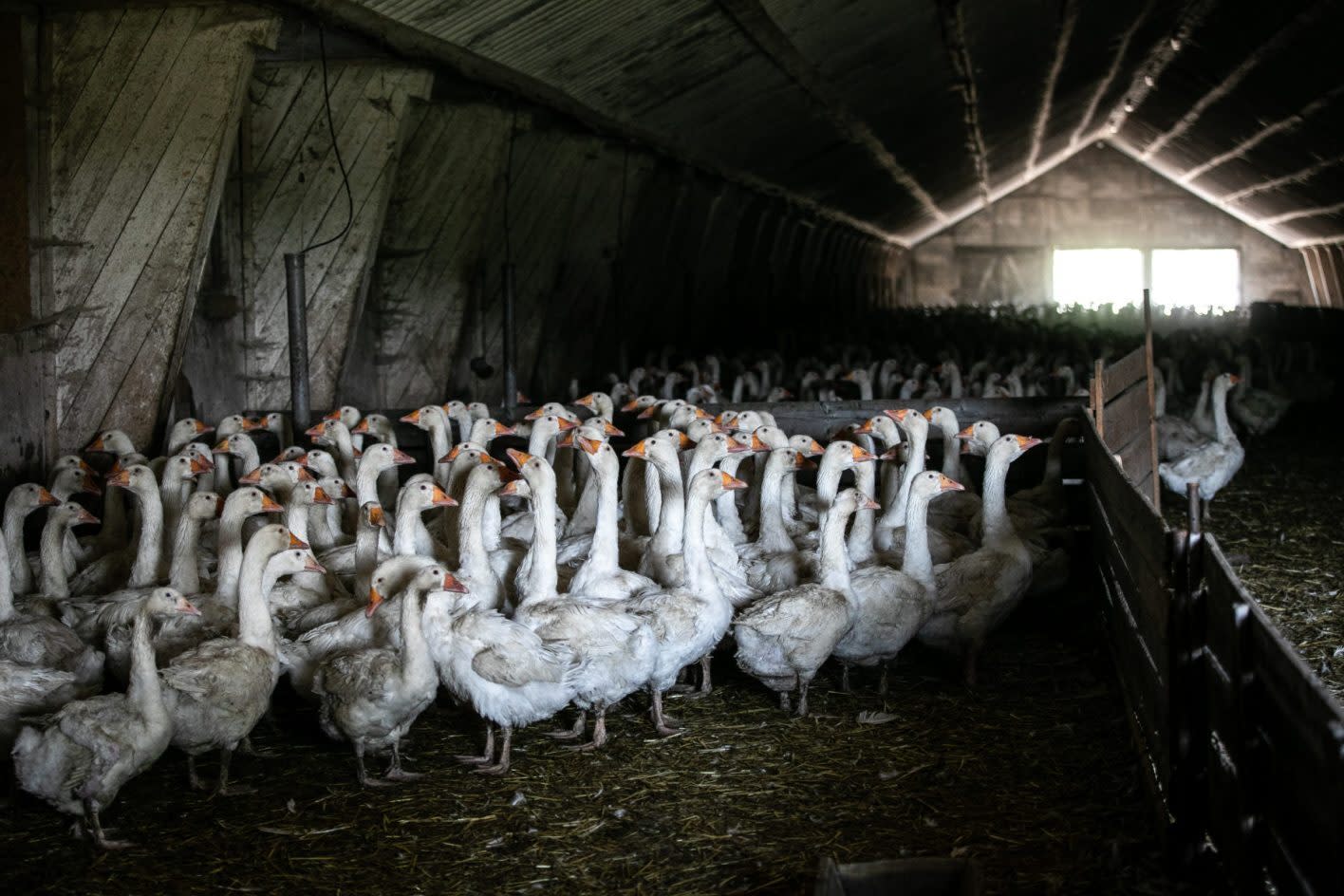




Poultry farming is mostly hidden from sight in the US. So what does it involve, and what does it mean for animals?

Compared to farming cows for meat and dairy, poultry farming can seem like a better choice, at least from an environmental point of view.
But the reality is that all factory farms are polluters of water, land, and air, not to mention rife with significant animal welfare issues.
What is poultry farming?
Poultry farms raise birds: chickens, turkeys, ducks, geese, and others. As with other types of animals, the farming industry's marketing would have you believe that these birds live free range, over miles of rolling pastures, resulting in plump, happy birds.
Unfortunately, this isn’t the case for the vast majority of farmed birds. Instead, many are jammed into cages with barely enough space to stand, while others are force-fed in the name of gastronomic delicacies.
What are the types of poultry?
Any type of bird raised on a farm is considered poultry. Some of the most commonly raised are chickens (both for meat and eggs), along with ducks, geese, turkeys, and guinea fowl.
Chickens
Chicken farms are the most common type of poultry farm with millions of chickens being farmed around the world at any one time.
Broiler chickens (those raised for meat) are sometimes described as “Frankenchickens” because they grow so quickly, genetically selected over decades to maximize productivity. This swift growth rate leads to painful health conditions of their heart, legs, and bones.
Turkeys
Turkeys raised on factory farms suffer from similar overcrowded conditions as chickens. Turkeys have their beaks trimmed, and develop numerous other painful conditions.
Ducks
In addition to being farmed for meat, ducks and geese are also raised to produce foie gras, a food considered one of the cruelest currently available.
Foie gras translates to “fat liver” as it is made from the excessively fatty liver of ducks or geese. To fatten their livers, ducks and geese are force fed several times a day. Tubes are forced down their throats which can cause damage and injury. Additionally, the birds are kept confined in small cages to prevent them from moving and burning calories. These conditions also prevent them from engaging in natural behaviors.
While the production and sale of foie gras has been outlawed in California (a similar move was attempted in New York), the production and sale of this horrific product is still allowed throughout most of the country.
Geese
Have you ever wondered where the down in coats, pillows, and blankets come from? The answer is geese or ducks; in particular the soft feathers grow as an undercoat, called 'down'.
Some down is plucked while birds are alive; this is also known as “live-plucking”. The more times a bird is plucked, the finer their down becomes, so they can endure being plucked several times before being slaughtered.
The US imports the vast majority of down products from countries in Europe and Asia that allow live plucking. A lack of clear labeling makes it hard for consumers to determine which products do and do not come from live-plucked birds.
Guinea fowl and squabs
Guinea fowl and squabs (a type of young pigeon) are raised in much smaller numbers than other types of poultry. While guinea fowl are slaughtered between 14 and 16 weeks, squabs are killed after only 28 days.
What are the issues with poultry farming?
Poultry farms are fraught with problems, especially on factory farms where the vast majority of farmed birds spend their lives.
Animal welfare
Animal welfare is a major concern on poultry farms. Not only are the birds’ lives cut short, but they’re full of horrific conditions and painful health issues.
Due to stress caused by a lack of enrichment (things that allow them to do what is natural to them like pecking and scratching for food) and overcrowding, birds on factory farms can peck at each other, causing injury. Instead of resolving the issues by improving welfare, the industry trims the birds' sensitive beaks—causing pain, and often decreasing what a bird will eat.
Birds are also bred to grow rapidly, causing health issues leading to increased suffering.
Food safety
Poultry is one of the major culprits for food-borne illnesses including salmonella and E. coli. Both bacteria are found in animal feces, and cause food poisoning, which can in some cases lead to death.
Antibiotic resistance
Poultry farms are perfect breeding grounds for bacteria and, as such, antibiotics are significantly overused. This in turn encourages bacteria to mutate against the antibiotics being used, becoming antibiotic resistant.
When analyzed, an alarming 71% of chicken products from Germany’s Lidl grocery brand 51 contained antibiotic-resistant bacteria.
Disease outbreaks
Poultry farms, especially chicken farms, have recently come under scrutiny as the likely source of the next global pandemic.
Millions of birds in countries around the world have already been wiped out due to bird flu. While currently the risk of the disease spreading to humans is low, there have been some cases of bird flu spreading to people.
Poultry farms are of particular concern as they provide the perfect environment for the disease to mutate and spread, not only among the birds but potentially to the farm staff, and then the greater community.
Predators
Poultry do have numerous predators, including cats and foxes. However, due to over-breeding in order to maximize productivity, the oversized birds are typically rendered defenseless. This inability to avoid predators on their own is often leveraged by producers as a justification for extreme confinement.
Does chicken farming affect the environment?
Though often touted as an environmentally friendly choice, chicken production does use a lot of water and impact the surrounding environment.
Does chicken production use a lot of water?
Yes, producing a single pound of chicken requires 519 gallons of water, far more than is required to produce most plant-based proteins.
Do chickens need a lot of food to grow?
No, which is part of the problem. A major focus of companies such as Cobb-Vantress and Aviagen, huge broiler breeders, is to minimize feed intake while maximizing growth rate. Or, to use their words, hit growth rates that achieve "cost-efficient performance."
Does poultry farming contaminate local water sources?
Factory farms are severely damaging to the environment, and poultry farms are not an exception. All animals produce waste—tons of it—and that waste can escape and pollute local waterways. Poultry waste is commonly used as fertilizer, however because factory poultry farms produce so much waste it’s often overapplied, running off of fields when it rains and causing land and water pollution.
How does the chicken industry claim to limit energy use?
One way is by swapping out traditional lights for eco-friendlier LEDs. Unfortunately, regardless of the type, lights are still being used to manipulate the natural growth cycle of the birds.
Egg-laying hens are sensitive to how long the days are, so by keeping the lights on for most of the day throughout the year, hens consistently lay a large number of eggs without the break they would naturally receive during the winter. The increase in eggs laid on factory farms compared to naturally causes hens numerous health conditions.
How much do chicken farms contribute to greenhouse gas emissions?
Eating just a 3.5 ounce serving of chicken is equivalent to driving a car 5.77 miles.
How do animal welfare regulations work?
Chicken, geese, ducks, and other poultry birds are sorely unprotected from abuse and neglect in the US and often excluded from basic welfare protections.
For example, while traditional battery cages have been outlawed in other parts of the world, they remain the most common form of confinement for chickens in the US. The psychological and physical torment of living inside of these inhumanely tight spaces are clear, and yet the confinement continues.
What can I do to help?
To ensure you're not supporting an industry that causes so much suffering to animals, simply swap products derived from animals for those that aren’t. You could switch your morning eggs for a delicious tofu scramble, or opt for blankets made from natural fibers rather than down-filled.
To make even more impact, you can support our campaigns. The Humane League US is working hard to relieve some of the worst suffering experienced by animals on factory farms. Join us as we push toward our vision of ending the abuse of animals raised for food.





